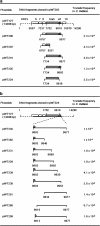Characterization of replication and conjugation of plasmid pWTY27 from a widely distributed Streptomyces species
- PMID: 23134842
- PMCID: PMC3583192
- DOI: 10.1186/1471-2180-12-253
Characterization of replication and conjugation of plasmid pWTY27 from a widely distributed Streptomyces species
Abstract
Background: Streptomyces species are widely distributed in natural habitats, such as soils, lakes, plants and some extreme environments. Replication loci of several Streptomyces theta-type plasmids have been reported, but are not characterized in details. Conjugation loci of some Streptomyces rolling-circle-type plasmids are identified and mechanism of conjugal transferring are described.
Results: We report the detection of a widely distributed Streptomyces strain Y27 and its indigenous plasmid pWTY27 from fourteen plants and four soil samples cross China by both culturing and nonculturing methods. The complete nucleotide sequence of pWTY27 consisted of 14,288 bp. A basic locus for plasmid replication comprised repAB genes and an adjacent iteron sequence, to a long inverted-repeat (ca. 105 bp) of which the RepA protein bound specifically in vitro, suggesting that RepA may recognize a second structure (e.g. a long stem-loop) of the iteron DNA. A plasmid containing the locus propagated in linear mode when the telomeres of a linear plasmid were attached, indicating a bi-directional replication mode for pWTY27. As for rolling-circle plasmids, a single traA gene and a clt sequence (covering 16 bp within traA and its adjacent 159 bp) on pWTY27 were required for plasmid transfer. TraA recognized and bound specifically to the two regions of the clt sequence, one containing all the four DC1 of 7 bp (TGACACC) and one DC2 (CCCGCCC) and most of IC1, and another covering two DC2 and part of IC1, suggesting formation of a high-ordered DNA-protein complex.
Conclusions: This work (i) isolates a widespread Streptomyces strain Y27 and sequences its indigenous theta-type plasmid pWTY27; (ii) identifies the replication and conjugation loci of pWTY27 and; (iii) characterizes the binding sequences of the RepA and TraA proteins.
Figures







Similar articles
-
Characterization of replication and conjugation of Streptomyces circular plasmids pFP1 and pFP11 and their ability to propagate in linear mode with artificially attached telomeres.Appl Environ Microbiol. 2008 Jun;74(11):3368-76. doi: 10.1128/AEM.00402-08. Epub 2008 Apr 4. Appl Environ Microbiol. 2008. PMID: 18390681 Free PMC article.
-
Characterization of a replication locus and formation of a higher-order complex between RepA protein and two inverted repeats in Streptomyces plasmid pSV1.FEMS Microbiol Lett. 2013 Dec;349(2):144-52. doi: 10.1111/1574-6968.12307. Epub 2013 Nov 5. FEMS Microbiol Lett. 2013. PMID: 24152230
-
Characterization of the genetic components of Streptomyces lividans linear plasmid SLP2 for replication in circular and linear modes.J Bacteriol. 2006 Oct;188(19):6851-7. doi: 10.1128/JB.00873-06. J Bacteriol. 2006. PMID: 16980488 Free PMC article.
-
Twenty years of the pPS10 replicon: insights on the molecular mechanism for the activation of DNA replication in iteron-containing bacterial plasmids.Plasmid. 2004 Sep;52(2):69-83. doi: 10.1016/j.plasmid.2004.06.002. Plasmid. 2004. PMID: 15336485 Review.
-
Conjugative DNA transfer in Streptomyces by TraB: is one protein enough?FEMS Microbiol Lett. 2012 Dec;337(2):81-8. doi: 10.1111/1574-6968.12031. FEMS Microbiol Lett. 2012. PMID: 23082971 Review.
Cited by
-
Comparative Genomics of Marine Sponge-Derived Streptomyces spp. Isolates SM17 and SM18 With Their Closest Terrestrial Relatives Provides Novel Insights Into Environmental Niche Adaptations and Secondary Metabolite Biosynthesis Potential.Front Microbiol. 2019 Jul 26;10:1713. doi: 10.3389/fmicb.2019.01713. eCollection 2019. Front Microbiol. 2019. PMID: 31404169 Free PMC article.
References
-
- Hopwood DA, Kieser T. In: Bacterial Conjugation. Clewell DB, editor. Plenum Press, New York; 1993. Conjugative plasmids of Streptomyces; pp. 293–311.
Publication types
MeSH terms
Substances
Associated data
- Actions
LinkOut - more resources
Full Text Sources
Molecular Biology Databases
Research Materials

